When I was nine I lived next door to a boy called Matthew. He was a year older than me and we had one of those strange childhood friendships that existed out of school as we rarely mixed in school. He was in the year above and, well at my school anyway, you didn't mix with the older children. We both loved the Fighting Fantasy books which were probably at their zenith by that time. Forest of Doom, Deathtrap Dungeon and the Island of the Lizard King we all conquered with a thumb firmly in between the previous choice so a quick exit back could be executed in case of death. We'd compete, probably along with many other kids, to get hold of the battered copies of Livingstone and Jackson's work at the local library and race home to enjoy them in the safety of our boyhood beds.
One day, I went over his house, probably with a box or two of plastic Airfix WW2 British (he ALWAYS played as the Germans) under my arm, expecting to see his Argos snooker table laid out for a 1944 skirmish. Instead I found him lolling on his bed, flicking rather carefully through a book. I knew it was a library copy as it was shrouded in one of those yellowing plastic jackets that librarians insisted on using twenty five years ago. As I walked in, he glanced up and casually through the book onto the floor.
As the book skidded to a halt on his paint flecked carpet, its cover gradually settled into my view. Two dangerous eyes stared suddenly into my own, eyes that glared from a figure who was partly Robin Hood, partly '80s Wood Elf and partly unknown hero. I had had my encounter with Lone Wolf!
 |
| My first sight of the classic Chalk style of fantasy art. Those eyes still haunt me! |
It took me quite a few years to make the connection between Lone Wolf, Gary Chalk and '80s Warhammer. To be honest, it was fairly recently. About 8 years ago now I started collecting back issues of White Dwarf, starting with issue 90 and working by way up until the tone of the magazine turned from '80s anarchy to '90s corporate lunch. I then began to work backwards from 90, picking up the magazine in the pre-Warhammer/Rogue Trader days when it was (nearly) always RPGs all the way. Gary's work cropped up here and there in my random purchases and I started to recognise his style in the old hardback GW books I horded in my bedroom and flicked through from time to time. It was a distinct style. Bright and engaging, and very much against the odds of the darker artwork abundant even then.
I was pleased, therefore, to produce a small article about his work for this blog, entitled The Magic of Warhammer Third Edition. Its seems that my posting was a popular one, as it has been viewed many times and discussed here and there by fans of Gary's work. Well, I am very pleased to say that Gary has agreed to be interviewed for this blog. We talk about his early career, his move into GW, Fantasy Warlord and beyond. Can I just take this opportunity to thank Gary personally for contributing to Realm of Chaos 80s and the Oldhammer Community. From your feedback, I know how much many of you enjoy these trips back down memory lane.
Over to Gary...
Orlygg
RoC80s: You were brought up in rural Hertfordshire, how did the country lad become interested in the fantastical in the first place?
GC: There wasn’t really a fantasy genre back in those days, or if there was I didn’t know about it. Doctor Who didn’t appear on tv until I was eleven years old and the world was only available in black and white. As a result I became interested in drawing and history which were about as far away from reality as I could get. I realised while reading Rosemary Sutcliff’s excellent historical fiction books that someone (Charles Keeping) was illustrating them and presumably getting paid for it. I decided me to become an illustrator, and thanks to a truly inspiring art teacher I fumbled my way into art school.
It wasn’t until I was leaving art school that the whole fantasy thing
began to kick off with Dungeons and Dragons arriving, science fiction books
appearing all over the place and everyone reading The Lord of the Rings. I just
wanted to illustrate kids books and suddenly there was all this stuff! The world was now available in technicolour.
Of course that could have been the effect of the drugs, but it doesn’t seem to
have worn off yet.
I got a job in a graphic design studio producing anything from shampoo
labels ( flash but regal ) to , and, I swear this is true,
airbrushing out an old lady’s wooden leg in a photo for something medical.
Classy eh? While I was doing this, I kept sending out illustration samples and
eventually manged to become a freelance children’s illustrator doing fairy tales
and stuff. Fantasy comes in a bit later, so keep reading…
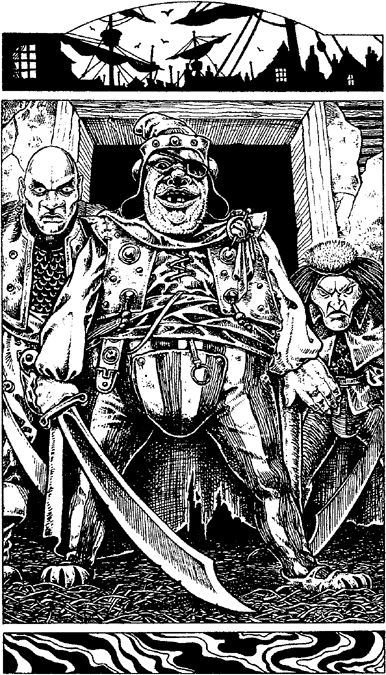 |
| Illustration from Lone Wolf II: Fire on the Water. |
GC: Wargames were originally played with Airfix figures, using Donald Featherstone’s rules. These were the only things available to a teenager who didn’t live in London. You played World War Two or American Civil War or spent your entire life converting tiny plastic men with the aid of plastecine. The strange thing was though, that these games were actually fun! As you know fun is no longer allowed unless it has accidentally slipped into a set of rules by accident. If this does occur, it’s usually weeded out by the fifteenth edition. We eventually started making up own rules for things, but it was okay because nobody ever found out.
There were no fantasy games around at all at this
time, except for those played by a mythical figure in a cardigan called Tony
Bath who played wargames set in Robert Howard’s Hyborea. As no-one in
Hertfordshire had ever heard of Conan or
Hyborea, these remained pretty much of an enigma. The D&D stuff comes in later…
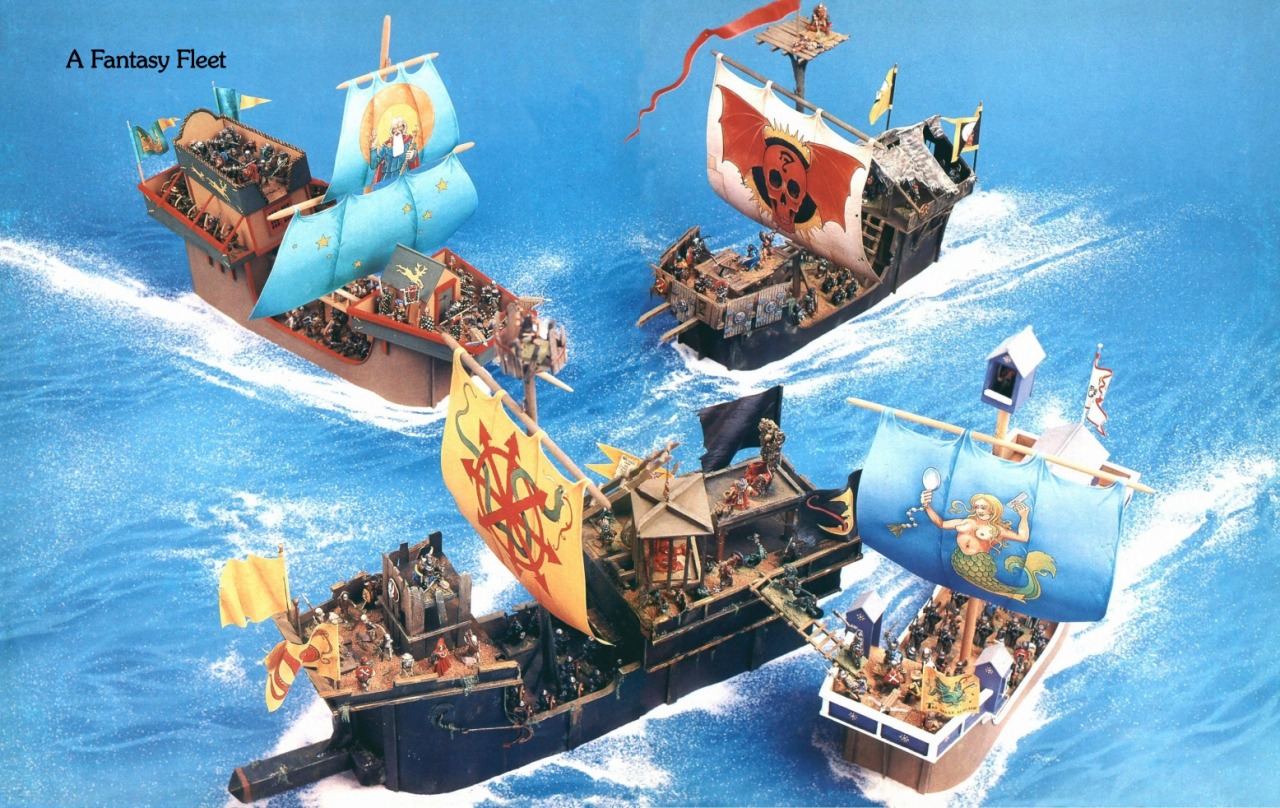 |
| Scratch-built model ships. Used in 'Every Dwarf loves a Sailor' and beyond. Gary Chalk 1986. |
GC: I moved into the games industry by inventing my own game! I had desk space in a printers and one day I was looking at a historical boardgame when I was espied by the two brothers who ran the place. They asked what it was and how much it cost. When I told them how much, they couldn’t believe the difference between the printing costs and the retail price and told me that if I made one up, they would print it. So I did.
I invented with Cry Havoc. I had recently started playing D&D ( I
told you it would eventually turn up) and was struck by the difference between
the roleplaying and existing historial games. Historcial games, even skirmish
games, had rather anonymous playing pieces who were all much the same, while
D&D had characters who were all different and could do more than just fight
each other. I tried to put a bit of the RPG flavour and colour into a
historical boardgame with individual characters with individual strengths. Cry
Havoc was born and I was a game designer.
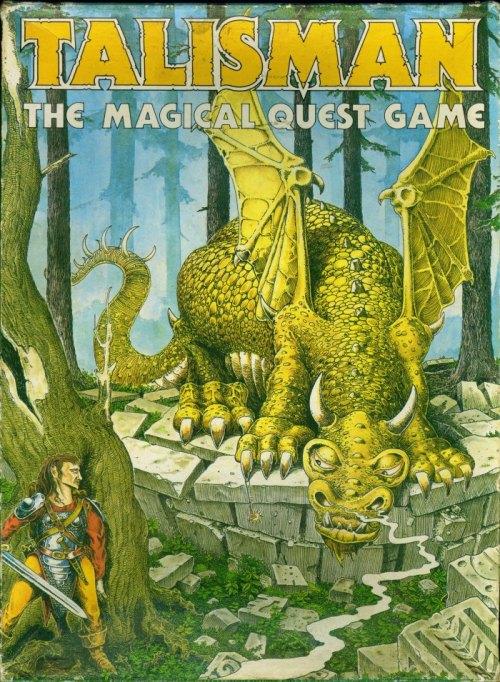 |
| Talisman: The magical Quest Game. First Edition 1983. Cover Art by Gary Chalk. |
GC: I first met Joe Dever when he was running the Game Centre near Oxford Street and I flogged him a load of copies of Cry Havoc. He need a lots of other products he couldn’t get a regular supply of and so I started a line of dungeon mapping pads and floorplans, which I also sold to him. At this time there were no gamebooks to get involved in and we started playing fantasy wargames using the Reaper and Laserburn rules along with historical games with the now widely available 25mm metal figures.
 |
| One of Gary's '80s dioramas. This one appeared in Fantasy Warlord among other places. |
GC: I left the printers as they had serious financial problems and were
milking Cry Havoc for cash, so that it could never really get anywhere. I went
to see Livingstone and Jackson at Games Workshop. They had repeatedly
threatened to sue me for plagerism over the dungeon planner pads and the
floorplans, but had never really been able to make it stick. I told them that
if they gave me a job, they wouldn’t have to keep trying to sue me and I could
even invent products for them. They thought this over and gave a job they
called Games Development Manager! I had an office, a drawing board and a view
of the car park. I was only in charge of myself, but hell, I was management
material!
Now this is where the story really starts. Joe Dever
was fired by the Game Centre and needed a job. Workshop needed a warehouse manager and I suggested Dever. He got the job. While I was working on
Talisman and Battlecars, Livingstone and Jackson came up with the idea of The
Wizard of Firetop Mountain, based on the solo Tunnels and Trolls adventures.
When this started to sell, they asked Joe if he would ghostwrite a solo
adventurefor them and if I would be prepared to illustrate it. All for a
princely 1% royalty. I pointed out to Joe that if we were good enough to write
their books we were good enough to produce our own. Joe wrote a section of the
first Lone Wolf book based on a world he had put together for his fantasy
wargames. I produced some illustrations and made up a presentation for the
publishers. As I recall, the text was put together by Workshop’s very own
typesetter in secret lunchtime sessions….
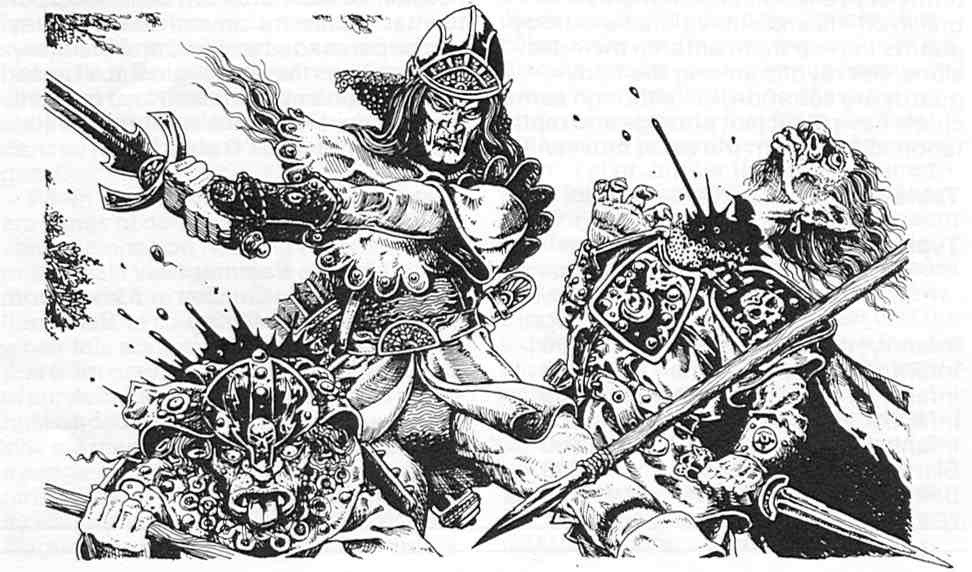 |
| Interior Illustration from White Dwarf 41. May 1983. By Gary Chalk. |
GC: It was great working with Jamie Thompson who was the editor at that time. He had a great sense of humour and was always slipping jokes and rude noms de plume into White Dwarf. I particularly remember a writer he called Hugh Janus ... This was back in the days when White Dwarf was still a magazine and even featured articles about other manufacturer’s games. The naval rules for Warhammer were written as I needed some for ships in my own games and decided to make an article out of them.
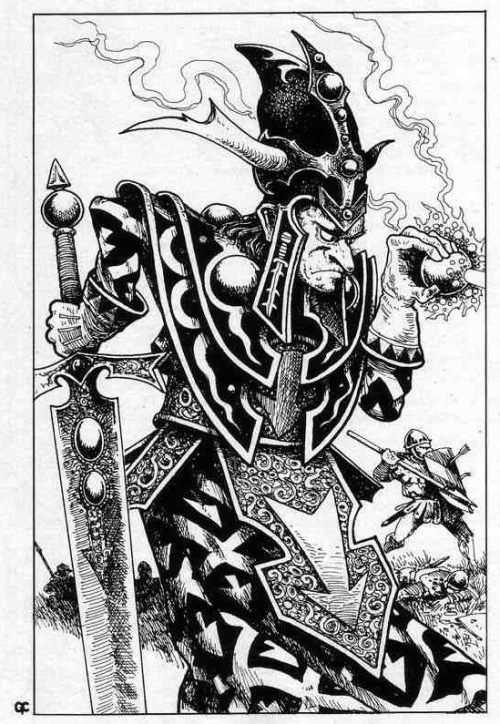 |
| Interior Illustration from White Dwarf 114. By Gary Chalk. |
RoC80s: Among old school Warhammer fans, you are probably most well known for the 2nd Edition expansion packs like Bloodbath at Orc’s Drift (which was played out at our recent Oldhammer Day at Bryan Ansell’s Wargames Foundry by the way) what is the story behind the creation of these scenarios?
GC: The story is that Workshop asked us to write a scenario for them. We were putting on some of the first really big fantasy wargames at Dragonmeet and Games Day. (Sometimes we used Warhammer and sometimes we put Warhammer rules on the table, but were secretly playing Reaper, ‘cos it was quicker. Weren’t we naughty! Anyway Bryan Ansell asked us to write a scenario and I came up with Orc’s Drift and Joe expanded it a bit so that it would use a lot of the latest releases in the Citadel figures range.
 |
| Interior Illustration from White Dwarf 113. Gary Chalk. 1989. |
RoC80s: You provided quite a bit of artwork to GW (and beyond) during the 1980s and many fans want to know what happened to the original pieces of art. Do you still have them in your possession or have they been sold on to collectors?
GC: I have some of the artwork, but a lot of it has gone missing at Games Workshop. They actually produced a boxed set of Lone Wolf figures at one time and I gave them the artwork for the first Lone Wolf book for the box lid. This is sadly one of the missing pieces. I have it on good autority that some of my artwork, along with that of other artists, was actually seen in a refuse skip outside the studio. Since the witness is an ex-Workshop sculptor, I can only assume this to be true. I am really pissed off about this as you can imagine.
RoC80s: You were involved in the ill-fated Fantasy Warlord project. What was the original vision behind the project and why do you think that it failed?
 |
| The ill-fated fantasy ruleset. |
GC: The original idea behind Fantasy Warlord was to produce a set of rules that actually allowed players to use tactics on the tabletop in a way which was realistic and relatively quick to play. I had given up playing Warhammer because it was incredibly slow to play with a lot of figures. By a lot, I mean two or three hundred a side. Warhammer is really a skirmish game. If twenty bowmen need to throw sixty dice to resolve their firing, then that, in my book, is a really clunky system. That’s why I went for the percentage based rules which allow you to resolve combat and firing with a single die roll.
I didn’t much like the ever increasing rules either. Chaos seemed to
need an enormous number of rules. Think about that for a moment… and the background was getting
so detailed that there was very little room for the gamer to be inventive. I
actually enjoy making up scenarios, war-engines, uniforms and so on that bolt on to the rules for my own games. I now
believe that I may be alone in this and this could be one reason why Fantasy
Warlord failed. People want to belong to a group where they are one of the
boys. They’re one of the people who play Warhammer or Malifaux or whatever, and ultimately it is
this community which is as important as the game. They like the in-jokes about
the third edition or getting the badges on their orcs to look just like the
ones in the magazine. I’m afraid to say, that I don’t really give a damn about
this stuff and I can make up my own badges. I must be some sort of pseudo geek
who isn’t really geeky…
There are lots of other reasons it was a disaster. We had figure makers
who lied about the number of sculptors they had and layout artists who really
did deserve to be laid out. We had packagers who were going out of business and
hadn’t told us and we had one of those little financial crisis things. The
Chancellor, Nigel Lawson, told it was going to be a little blip, but he lied.
Imagine that, a politician who tells lies. Seems impossible, doesn't it? Anyway,
the project seems to have been totally doomed form the moment of it’s
conception. I screwed up big time.
 |
| Interior Illustration from Warhammer Armies. Gary Chalk 1987. |
GC: Even though I haven’t had a lot to do with 40K recently I am still unravaged by Alzheimer’s and have followed its progress closely. I have even managed to read bits of White Dwarf down at the paper shop before they throw me out.
The reason I was asked to do the interview was nothing
more or less than flagrant nepotism! My son Titus who works as a journalist in
Berlin, is a friend of Samira Ahmed. She needed to find someone who knew about
Games Workshop’s products and he suggested me. Funny old world innit?
In my defence I can only say that I am familiar with Workshop’s products
and I have played both Warhammer Fantasy and 40K, indeed I actually play-tested
early versions of the rules. If they had interviewed someone who currently
worked for Workshop, it would have ended up as as a piece of advertising. I
told her what I honestly thought and that’s about it.
 |
| An intriguing piece from the Colleges of Magic article. The black dot? Design choice or a cover for something? |

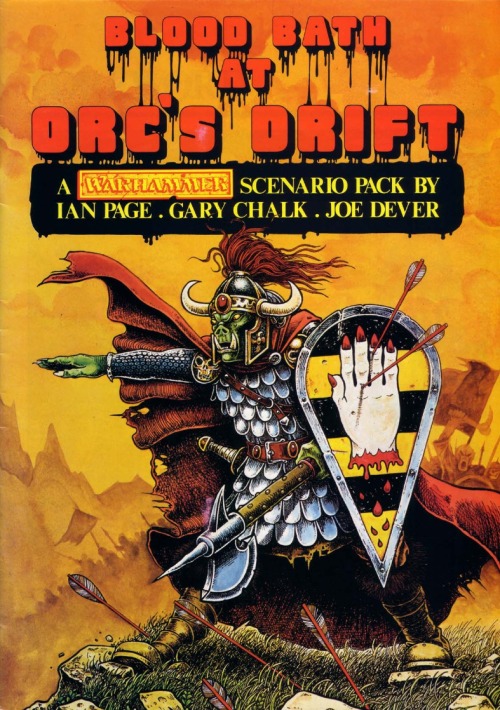
Great interview, I've always loved Gary's artwork. Didn't know he was responsible for Cry Havoc, though, I've still got my copy!
ReplyDeleteI can also sadly confirm that reams of original artwork ended up in a skip during the move from Enfield Chambers to Castle Boulevard. I was a Mail Order Troll at the time, and we were involved in the move. At the end of the day, we were unofficially allowed to rummage through the skips and take what we wanted.
Sadly, I think it'd rained, and so most of the artwork was already ruined. Sad times.
Did you take anything interesting from those skips now Evo? Go on! tell!
DeleteSeveral of those pics I'm only familiar with through Heroquest- great to see them in colour!
ReplyDeleteYes, looking back Gary's work really made the Heroquest game stand out didn't he? I still play the game from time to time and will look at the artwork with fresh eyes next time I do!
DeleteMy favourite quotes:
ReplyDelete'The strange thing was though, that these games were actually fun! As you know fun is no longer allowed unless it has accidentally slipped into a set of rules by accident. If this does occur, it’s usually weeded out by the fifteenth edition. We eventually started making up own rules for things, but it was okay because nobody ever found out.'
'I had given up playing Warhammer because it was incredibly slow to play with a lot of figures. By a lot, I mean two or three hundred a side. Warhammer is really a skirmish game. If twenty bowmen need to throw sixty dice to resolve their firing, then that, in my book, is a really clunky system.'
Also, if the story about Mr Chalk's work ending up in the rubbish is true, my ire towards GW is only increased.
It really depends on when the artwork was seen. GW has been (at least) 3 distinct companies, and has had more significant changes in culture than that. Things like that tend to be done by one or two people in "cleaning up". I've got no love for current GW, but I doubt Kirby sat on his pile of gold, laughing and bellowing "Chalk's artwork? Out with it!"
DeleteWhat struck me about that story was that the ex-sculptor apparently didn't fish all of the artwork out of the skip and either return it or keep it...
As I said, I was there on the day, and by the time it was noticed, it was all ruined. My thoughts on the matter, looking back, was that it was seen as 'obsolete product'. It'd been used for systems/games that were at that point, beyond end of life.
DeleteUndoubtedly it'd all been photographed for production, so there must still be an archive of it all at GW, somewhere. Unless that's suffered a similar purge during the move from the Boulevard to the Fuhrerbunker.
As gaming frothers back in the day, we were more interested in the greens, 3ups and assorted figures in there, though I did end up with the scenery used in the Slaves to Darkness book. I dearly regret not picking up the artwork and trying to carefully dry it out, though.
Have you still got the RoC scenery then Evo?
DeleteI've got two tiny parts of it left, I'll chuck up a couple of photos on my blog when I get time. I regrettably sold off my entire collection in the late 90's when I desperately needed money, and thought I was never going to get back into wargaming.
DeleteI've spent the last decade or so regretting that decision, and trying to re-buy everything I used to have!
From memory, what I personally got out of the skip was:
- All of the scenery from Slaves to Darkness.
- A bunch of 3-ups for the first few Epic sprues.
- A set of parts for a never released series of modular chaos warriors.
- Boxes of figures, all part painted. Presumably the 'Eavy Metal team had a clearout in the move.
There was more, I'm sure.
I've put up a short post with a couple of photos up at my blog: http://port-imperiale.blogspot.co.uk/2013/10/raiders-of-lost-skip.html
DeleteAbsolutely love that monestry siege diorama. The wizard spitting forth great torents of flame is really epic! Cooool as.
ReplyDeleteI too really like this diorama. I think I need to track down a copy of the book to scan up all the other dioramas that must be inside.
DeleteWhat a witty and entertaining chap Gary Chalk is - thanks for another great interview Orllyg.
ReplyDeleteNot seen the monastery diorama before either - brilliant!
What a shame about those original artworks and their fate...
Brilliant read, Thanks for sharing. I remeber not Boeing that fond of Chalk's style back in the time, but I've since come to like his illustrations a lot. Btw, if I remember correctly, the Black dot on the wizard in the last illustration hides a Chaotic Rune, which would have made him less suited for the article.
ReplyDeleteAll the best,
Kasper
I was thinking along similar lines, though I was wondering if it was the Khorne rune and therefore not appropriate for magic.
DeleteLoved this interview, thanks for posting it!
ReplyDeleteI totally adore GC's work on Lone Wolf. Now I'll have to try and track down some of the other things mentioned here :)
Thanks for all these wonderful interviews - I've really enjoyed every one.
ReplyDeleteOne person I'd really like you to interview, if it were possible, would be Nigel Stillman, who wrote the 3rd ed armies book, among a load of other things. I don't know how you go tracking old GW employees down, but he'd be one I'd like to read.
Many thanks again for all the interviews/other inspiring posts - keep it up!
Another exceptional interview.
ReplyDeleteAnother great interview. Though now I'm intrigued. I'd love to see a follow-up article where you ask about things like the black dot, and perhaps what it was like/how it changed in the studio while he was there, and how it was when he left, along with what he's been up to since then. Maybe even if the FW rules might be seen now/again in the days of electronic publishing (not a huge Kickstarter, but maybe an affordable PDF like SOBH or even just put it out there like KoW)
ReplyDeleteWhen you do these interviews, you have to respect what the interviewee is willing to share. There are some things that people just don't want to share, or cannot talk about. I tend not to probe too deeply to be honest, I am just happy that people want to contribute to the site. Though I do tend to wield a fairly strong editing hand, and the stuff that I have not printed would make a fair few of your hairs stand up on end! In fact, I have been personally thanked more than once for editing out a few choice phrases here and there! (;
DeleteFantastic interview. Thanks for making this happen Orlygg ! I didn't know Mr. Chalk was responsible for Cry Havoc. I played a few times and it was a great system, maybe a bit too simple for our times, but with playability in mind. Spin offs by Jeux Descartes were decent too.
ReplyDeleteThank you for your support. I think we need to track down a copy or two of Cry Havoc and try it out!
Deletemany of this illustrations were also used inside Heroquest instructions booklet
ReplyDeleteThis black dot on the wizard's robe is an icon of Tzeentch.
ReplyDeleteYou are quite correct. We solved the mystery here...
Deletehttp://realmofchaos80s.blogspot.co.uk/2014/09/gary-chalk-wizard-art-mystery-solved.html
What you didn't know is that in the original (first edition) painting, the robed wizard is a sorceror of Khorne! Yes, I did not make a typo. The first icon painted on the robe is the sysmbol of Khorne. I suspect Gary Chalk just took a nice looking icon and painted it on the robe. GW then corrected him by saying those Khorne guys don't do magic spells... A story of true Chaos misdirection an magical deceit indeed. :-) Smells like the work of Tzeentch. ;-)
ReplyDelete